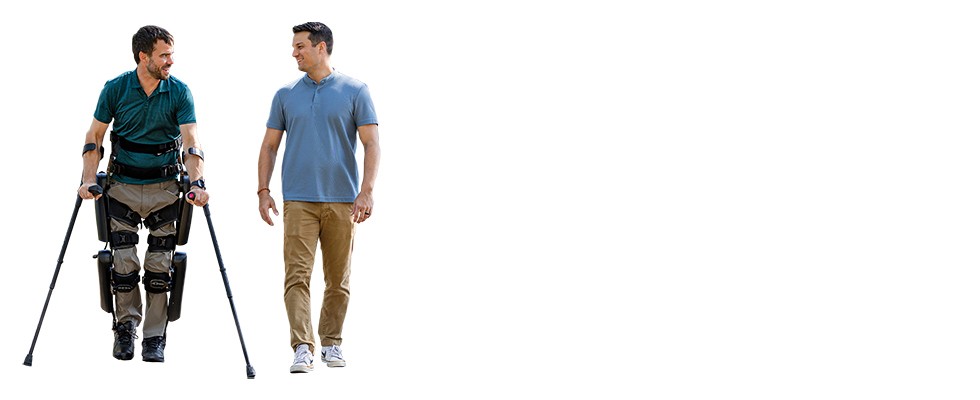
They sound like something from science fiction: powered, wearable robots that help people with serious spinal injuries or other mobility issues walk upright. Even the name—exoskeletons—puts it in a separate category from most mobility devices, and possible integration with artificial intelligence (AI) feels even more futuristic.
But medical exoskeletons are a reality and on the market, albeit in a limited fashion. They’re more like bespoke haute couture than off-the-shelf orthotics or wheelchairs, but manufacturers say they have the potential to transform the lives of people with disabilities and mobility limitations. And they’ve reached major milestones in recent months—including a Medicare reimbursement pathway for exoskeleton use that opens the door to reimbursements.
The Rise of Wearable Robots
Exoskeletons have been a source of invention for centuries, often with a goal of equipping people to carry extra weight or prepare for battle. Modern development began in earnest in the 1960s and ’70s, and by the early 2000s, exoskeletons were in use for gait rehabilitation for people who had experienced stroke or spinal cord injuries (SCI).
Since then, the science has improved significantly and research has expanded. Militaries use—and are working to develop—exoskeletons either for protection or to increase strength and endurance. Industrial exoskeletons promise to allow workers to lift heavier weights and avoid injuries; some have been marketed for homecare nurses and aides to transfer patients more safely. And there’s a burgeoning market of recreational all-terrain exoskeletons designed to power hikers over more miles than they can manage unassisted.
Powered exoskeletons for medical uses, on the other hand, have largely been limited to rehabilitation centers or a few private patients, mostly due to the cost of the machines, which runs anywhere from $40,000 to over $100,000. Roughly a dozen companies have had exoskeletons approved for clinical, monitored rehab use by the Food and Drug Administration (FDA); at least two have been approved for at-home use.
In 2023, the Centers for Medicare & Medicaid Services (CMS) published a final rule that defined powered orthoses and exoskeletons as “braces.” Perhaps the biggest shift came in 2024, when CMS put exoskeletons in the Durable Medical Equipment, Prosthetics, Orthotics and Supplies (DMEPOS) fee schedule—allowing Medicaid to cover them in the brace benefit category. HCPCS Code K 1007 is described as a “bilateral hip, knee, ankle, foot device, powered, includes pelvic component, single or double upright(s), knee joints any type, with our without ankle joints any type, etc.” Personal medical exoskeletons generally need to be used along with an additional mobility aid such as a walker or crutches.
Primary Makers
Right now, the code and coverage primarily applies to two manufacturers: Ekso Bionics, which makes the Indego Personal exoskeleton and other devices, and Lifeward, which launched the newest version of its ReWalk exoskeleton, ReWalk 7, in April.
Ekso recently named National Seating and Mobility as its exclusive distributor within the U.S. complex rehab technology industry; prosthetics and orthotics (PO) company Bionic P&O was named a nonexclusive PO provider. And, in its recent earnings call, Ekso Bionics CEO Scott Davis said the company had its first patient claim for the Indego Personal exoskeleton last quarter and has developed a pipeline of more than 35 Medicare beneficiaries the company thinks are qualified candidates for the Indego this year.
Meanwhile, Lifeward announced recently that for the first time, a major U.S. health insurer approved the payment for one of its beneficiaries for its ReWalk 7 Personal Exoskeleton—which was launched for U.S. sales on April 15. Lifeward has also recently partnered with CorLife, a division of NuMotion, to exclusively distribute the ReWalk Personal Exoskeleton in the workers’ compensation market.
“Expanding access for individuals with SCI to our ReWalk Personal Exoskeleton has been a key strategic initiative for Lifeward,” Larry Jasinski, the company’s then-CEO, said in the announcement. (Lifeward announced just before press time that Mark Grant would take over as president and CEO June 2.) “Commercial health insurers cover a significant proportion of individuals with SCI in the U.S.”
These devices won’t be on the shelves of durable medical equipment stores any time soon, as they require a lengthy approval process and significant fitting and training. Battery and other limitations mean the
suits are not likely to be the only mobility device for most users, although they could have applications for travel and transportation—users can easily transfer into and out of a vehicle, although they are not approved for driving—and also provide rehab and relief for some people with spinal cord injuries.
And while some in the disability community have called exoskeletons ableist because they prioritize standing and walking, users say they love being able to do household tasks like cooking and cleaning or socialize with friends and family more easily than they can with a wheelchair alone.
“Regaining my independence and mobility has been incredibly empowering,” Debbie Wagoner, the first person to receive an Ekso Indego Personal exoskeleton through CMS, said in a press release posted by Ekso Bionics. “The ability to stand and walk through use of this device has been instrumental in my rehabilitation journey, both physically and emotionally, and helped me not only recover but thrive.”
